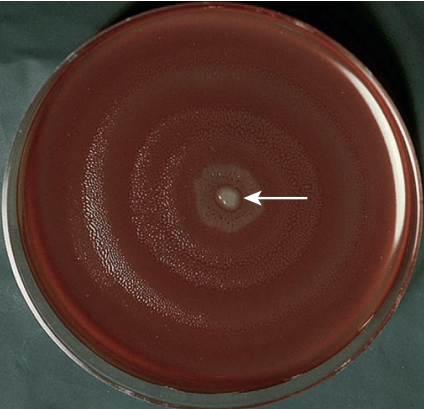ASCPi-MICROBIOLOGY
- Description
- Curriculum
- Reviews
-
1HD TUTORIAL - SPECIMEN PROCESSING
-
2PPT - SPECIMEN COLLECTION AND PROCESSING + ASCPi focus Questions
-
3SPECIMEN COLLECTION AND PROCESSING
-
4HD TUTORIAL - BACTERIAL COLONY MORPHOLOGY
-
5COLONY MORPHOLOGY FOR THE IDENTIFICATION OF MICROORGANISMS
-
6HD TUTORIAL BIOCHEMICALS FOR BACTERIAL COLONIES
-
7BIOCHEMICAL IDENTIFICATION OF GRAM-NEGATIVE BACTERIA
-
8ANTIMICROBIAL SUSCEPTIBILITY TESTING
-
9RECORDED - ANTIMICROBIAL SUSCEPTIBILITY TESTING
Antimicrobial susceptibility testing (AST) is performed on bacteria isolated from clinical specimens to determine which antimicrobial agents might be effective in treating infections caused by the bacteria. Only bacteria that are likely to be contributing to an infection should be tested.
Susceptibility testing is usually performed by a disk diffusion or dilution (minimal inhibitory concentration) method.
-
10PPT - COLONY MORPHOLOGY FOR BACTERIAL IDENTIFICATION
-
11HD TUTORIAL VIDEO - STAPHS AND STREPTOS
-
12STAPHYLOCOCCACEAE
-
13HD TUTORIAL - STAPHS AND STREP PLUS ASCPi QUESTIONS
-
14STREPTOCOCCACEAE AND OTHER RELATED ORGANISMS
-
15HD TUTORIAL - ENTEROBACTERIACEAE
-
16ENTEROBACTERIACEAE
-
17HD TUTORIAL - NEISSERIACEAE PATHOGENIC
-
18HD TUTORIAL - MORAXELLA, NON PATHOGENIC NEISSERIA AND HEMOPHILUS
-
19NEISSERIACEAE AND MORAXELLACEAE
-
20HD TUTORIAL - HACEK GROUP OF BACTERIA
-
21HAEMOPHILUS AND OTHER FASTIDIOUS GRAM-NEGATIVE SPECIES
-
22HD TUTORIAL - OTHER FASTIDIOUS GRAM NEGATIVE BACILLI
-
23OTHER FASTIDIOUS GRAM-NEGATIVE BACILLI, BORDETELLA AND LEGIONELLA SPP.
-
24HD TUTORIAL - VIBRIO AND AEROMONAS SPP
-
25HD TUTORIAL - CAMPYLOBACTER + ASCPi QUESTIONS
-
26VIBRIO, AEROMONAS, PLESIOMONAS, AND CAMPYLOBACTER SPECIES
-
27HD TUTORIAL - NON-FERMENTERS G-VE BACILLI
-
28NONFERMENTING GRAM-NEGATIVE BACILLI
-
29HD TUTORIAL - ANAEROBES OF CLINICAL IMPORTANCE
-
30ANAEROBES OF CLINICAL IMPORTANCE
-
31HD TUTORIAL - THE SPIROCHETES
-
32THE SPIROCHETES
-
33THE SPIROCHETES PRACTICE QUESTIONS
-
34HD TURORIAL - CHLAMIDIA AND RICKETTSIA
-
35CHLAMYDIA, RICKETTSIA, AND SIMILAR ORGANISMS
-
36HD TUTORIAL - MYCOPLASMA AND UREAPLASMA
-
37MYCOPLASMA AND UREAPLASMA
Mycoplasmas are the smallest self-replicating organisms in nature.
-
38HD TUTORIAL - MTB AND NTM
-
39MTB AND NTM LESSON 1
MTB and Mycobacterium leprae, the causative agents of tuberculosis (TB) and Hansen disease (leprosy), respectively.
-
40HD TUTORIALS - MTB NTM LAB DIAGNOSIS
-
41MTB AND NTM LESSON 2 - LABORATORY DIAGNOSIS
Rate of growth, colony morphology, pigmentation, nutritional requirements, optimal incubation temperature, and biochemical test results; broth-based culture systems and species-specific nucleic acid probes (PCR) and HPLC are used to identify mycobacteria.
-
42MTB & NTM PRACTICE QUESTIONS
-
43HD TUTORIAL - MEDICAL MYCOLOGY
-
44CLINICAL MYCOLOGY - INTRODUCTION
-
45CLINICAL MYCOLOGY
Mycoses (singular, mycosis) are diseases caused by fungi. Fungal disease is categorized based on the site of the infection—superficial, cutaneous, subcutaneous, and systemic mycoses.
-
46LABORATORY DIAGNOSIS OF FUNGI
-
47THE PROTOZOA
-
48RECORDED LECTURE - PROTOZOLOGY PART I
E. histolytica and E. dispar are morphologically identical organisms that differ in their effects on the host. Recently, Entamoeba moshkovkii, has been identified as belonging to this complex. E. dispar is considered a nonpathogenic E. histolytica, whereas the pathogenic organism remained E. histolytic and E. moshkovkii is thought to be a freeliving organism
-
49RECORDED LECTURE - PROTOZOLOGY PART II
Free-living, thermotolerant amebae found in soil and water usually feed on bacteria in the environment but are known to be capable of causing human disease. They are able to gain access to the CNS by inhalation into the upper respiratory tract followed by penetration of the nasal mucosa, which allows them to travel along the olfactory nerve to the brain, or by hematogenous spread from the lungs or skin lesions. These infections are very difficult to diagnose and treat and are associated with a high mortality rate.
-
50THE PHYLUM APICOMPLEXA
-
51RECORDED LECTURE - APICOMPLEXA PART I
Plasmodium spp., which cause malaria, remain endemic throughout the world in tropical and subtropical countries. Plasmodium vivax, Plasmodium ovale, Plasmodium malariae, and Plasmodium falciparum are the causative agents of human malaria. In general, infections caused by P. vivax, P. ovale, and P. malariae are less severe than those caused by P. falciparum. A fifth species, Plasmodium knowlesi, which causes malaria in the macaque monkey, has also been implicated in cases of zoonotic human malaria in Malaysia and the Philippines.
-
52RECORDED LECTURE - APICOMPLEXA PART II
Babesiosis is a zoonotic intraerythrocytic infection transmitted by the bite of a tick. Although Babesia microti and B. Babesia hominis, have been reported to infect humans, B. microti is the most common. The hard tick (Ixodes spp.) serves as the vector, and white-footed mice and white-tailed deer are the reservoirs. There also have been simultaneous transmission of B. microti and Borrelia burgdorferi (the causative agent of Lyme disease) because these two organisms use the same tick vector.
-
53DIAGNOSTIC HELMONTHOLOGY PART 1
-
54RECORDED LECTURE - HELMINTHOLOGY PART I
Helminth infections in humans are caused by flukes, tapeworms, or roundworms. Humans become infected by directly ingesting eggs (ova), by ingesting larvae in an intermediate host, or through direct larval penetration of the skin. The pathology and severity of infection are related to the number of adults present, referred to as the worm burden. Most of the parasites inhabit the intestinal tract, but species also infect the liver, lungs, lymphatics, and blood vessels.
-
55DIAGNOSTIC HELMINTHOLOGY PART 2
-
56RECORDED LECTURE - HELMINTHOLOGY PART II
Human roundworms include those that infect the intestinal tract and blood and tissue. These organisms are transmitted by the ingestion of the embryonated egg or by direct penetration of the skin by larvae in the soil, or they may require an insect vector. Roundworms are characterized by the presence of two sexes and a life cycle that may involve larval migration throughout the body. The adults obtain nourishment by absorbing nutrients from partly digested intestinal contents or by sucking blood. Patients may be asymptomatic or symptomatic; the severity of the symptoms is related to the worm burden, host’s nutritional status and age, and duration of infection. Most roundworm infections can be treated with oral albendazole or mebendazole.
-
57GENERAL PARASITOLOGY LABORATORY TECHNIQUES
-
58RECORDED LECTURE - PARASITOLOGY TECHS
Formalin can be used when a wet mount or concentration procedure (sedimentation or flotation) will be performed. The fixative sodium acetate–acetic acid–formalin (SAF) can be used for the preservation of fecal specimens when concentration procedures and permanent stains will be used. Vials of merthiolate-iodine-formalin (MIF) can also be used to preserve trophozoites, cysts, larvae, and helminth eggs for wet mount or concentration procedures. This preservative, however, is not routinely used for permanently stained smears.








